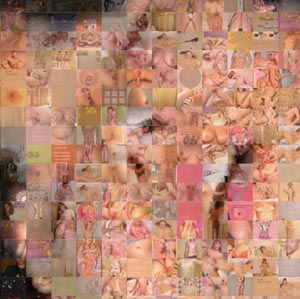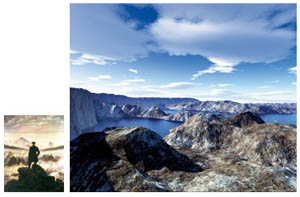Pedro Meyer, founder of ZoneZero, the pioneering photography site, just wrote to say that he’s working on an Ipod version of I Photograph to Remember, the cdrom he made in the early 90s. It’s a deeply moving portrait documenting the last years of his parents’ life. Pedro invites readers of if:book to download a beta version HERE. He’s hoping for feedback so please send comments.
I thought it might be interesting to describe the debut of IPTR at the Digital World Conference in Beverly Hills in 1991. To appreciate this you have to understand that at that time no one had ever really seen anything on a computer screen with emotional content. The audience consisted of hyperactive, mostly male, senior executives who normally couldn’t sit still or be quiet for five minutes. But for thirty-two minutes, from the moment the lights went down till the closing credits, there wasn’t even the sound of breathing. People were literally stunned as they suddenly realized that the number-crunching, text processing machine on their desk could convey complex, profound feelings.
Category Archives: voyager
working in the open
From 1984 to 1996 i had the good fortune to be a part of Voyager, an innovative publisher known for The Criterion Collection, which started in 1984 as a series of laser videodiscs, innovative cd-roms, the first credible electronic books in the Expanded Books series, and even a few landmarks on the web including the first audio webcast which fielded questions from remote listeners. We were a wide-eyed group inventing things as we went along. Nothing happened without intense in-house discussion and debate over the complex new relationships between form and content afforded by new technologies. But realistically the discussion was limited at the most to the hundred or so people at any one time who were involved in development of Voyager’s titles.
Through another stroke of luck i’ve managed to be part of a second wonderfully creative group which is having as much fun navigating uncharted waters as we did at Voyager. However this time, thanks to the network, my colleagues and i are working out in the open. And because others are able to listen in as we “think out loud” and then “chime-in” if they have something to contribute, the discussion is ever so much broader, deeper and fundamentally useful.
This thought came to me this morning when i looked at the discussion on if:book about MediaCommons and realized how remarkable a group of people had contributed so far and how much quicker the discussion is developing than it ever could have if it had just been my colleagues and i discussing this around a table.
truth through the layers
 Pedro Meyer’s I Photograph to Remember is a work originally designed for CD ROM, that became available on the Internet 10 years later. I find it not only beautiful within the medium limitations, as Pedro says on his 2001 comment, but actually perfectly suited for both, the original CD ROM, and its current home on the internet . It is a work of love, and as such it has a purity that transcends all media.
Pedro Meyer’s I Photograph to Remember is a work originally designed for CD ROM, that became available on the Internet 10 years later. I find it not only beautiful within the medium limitations, as Pedro says on his 2001 comment, but actually perfectly suited for both, the original CD ROM, and its current home on the internet . It is a work of love, and as such it has a purity that transcends all media.
The photographs and their subject(s) have such degree of intimacy that forces the viewer to look inside and avoid all morbidity or voyeurism. The images are accompanied by Pedro Meyer’s voice. His narration, plain and to the point, is as photographic as the pictures are eloquent. The line between text and image is blurred in the most perfect b&w sense. The work evokes feelings of unconditional love, of hands held at moments of both weakness and strength, of happiness and sadness, of true friendship, which is the basis of true love. The whole experience becomes introspection, on the screen and in the mind of the viewer.
IPTR was originally a Voyager CD ROM, and it was the first ever produced with continuous sound and images, a possibility that completes, and complements, image as narration and vice-versa. The other day Bob Stein showed me IPTR on his iPod and expressed how perfectly it works on this handheld device. And, it does. IPTR is still a perfect object, and as those old photographs exist thanks to the magic of chemicals and light, this exists thanks to that “old” CD ROM technology, and will continue to exist inhabiting whatever medium necessary to preserve it.
 I’ve recently viewed Joan de Fontcuberta’s shows in two galleries in Manhattan; Zabriskie and Aperture,) and the connections between IPTR and these works became obsessive to me. Fontcuberta, also a photographer, has chosen the Internet, and computer technology, as the media for both projects. In “Googlegrams,” he uses the Google image search engine to randomly select images from the Internet by controlling the search engine criteria with only the input of specific key words.
I’ve recently viewed Joan de Fontcuberta’s shows in two galleries in Manhattan; Zabriskie and Aperture,) and the connections between IPTR and these works became obsessive to me. Fontcuberta, also a photographer, has chosen the Internet, and computer technology, as the media for both projects. In “Googlegrams,” he uses the Google image search engine to randomly select images from the Internet by controlling the search engine criteria with only the input of specific key words.
These Google-selected images are then electronically assembled into a larger image, usually a photo, of Fontcuberta’s choosing (for example, the image of a homeless man sleeping on the sidewalk reassembled from images of the 24 richest people in the world, Lynddie England reassembled from images of the Abu Ghraib’s abuse, or a porno picture reassembled from porno sites.). The end result is an interesting metaphor for the Internet and the relationship between electronic mass media and the creation of our collective consciousness.
For Fontcuberta, the Internet is “the supreme expression of a culture which takes it for granted that recording, classifying, interpreting, archiving and narrating in images is something inherent in a whole range of human actions, from the most private and personal to the most overt and public.” All is mediated by the myriad representations on the global information space. As Zabriskie’s Press Release says, “the thousands of images that comprise the Googlegrams, in their diminutive role as tiles in a mosaic, become a visual representation of the anonymous discourse of the internet.”
 Aperture is showing Fontcuberta’s “Landscapes Without Memory” where the artist uses computer software that renders three-dimensional images of landscapes based on information scanned from two-dimensional sources (usually satellite surveys or cartographic data.) In “Landscapes of Landscapes” Fontcuberta feeds the software fragments of pictures by Turner, Cézanne, Dalí, Stieglitz, and others, forcing the program to interpret this landscapes as “real.”
Aperture is showing Fontcuberta’s “Landscapes Without Memory” where the artist uses computer software that renders three-dimensional images of landscapes based on information scanned from two-dimensional sources (usually satellite surveys or cartographic data.) In “Landscapes of Landscapes” Fontcuberta feeds the software fragments of pictures by Turner, Cézanne, Dalí, Stieglitz, and others, forcing the program to interpret this landscapes as “real.”
These painted and photographic landscapes are transformed into three-dimensional mountains, rivers, valleys, and clouds. The result is new, completely artificial realities produced by the software’s interpretation of realities that have been already interpreted by the painters. In the “Bodyscapes” series, Fontcuberta uses the same software to reinterpret photographs of fragments of his own body, resulting in virtual landscapes of a new world. By fooling the computer Fontcuberta challenges the limits between art, science and illusion.
Both Pedro Meyer and Joan de Fontcuberta’s use of photography, technology and the Internet, present us with mediated worlds that move us to rethink the vocabulary of art and representation which are constantly enriched by the means by which they are delivered.
